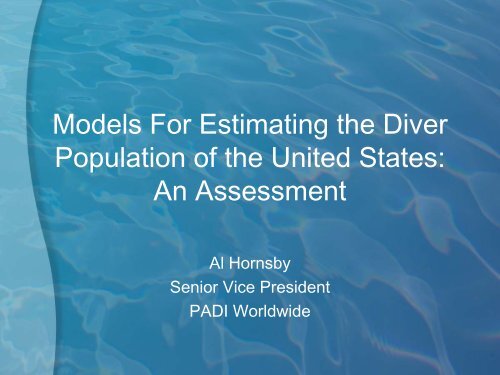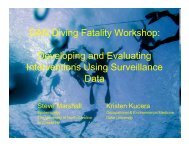Models For Estimating the Diver Population of the United States: An ...
Models For Estimating the Diver Population of the United States: An ...
Models For Estimating the Diver Population of the United States: An ...
Create successful ePaper yourself
Turn your PDF publications into a flip-book with our unique Google optimized e-Paper software.
<strong>Models</strong> <strong>For</strong> <strong>Estimating</strong> <strong>the</strong> <strong>Diver</strong><strong>Population</strong> <strong>of</strong> <strong>the</strong> <strong>United</strong> <strong>States</strong>:<strong>An</strong> AssessmentAl HornsbySenior Vice PresidentPADI Worldwide
The <strong>Diver</strong> <strong>Population</strong>• There are differing arguments over what<strong>the</strong> U.S. diver population is• But, it is critical to have a reasonablepopulation estimate to generate a realisticdiver fatality rate
The <strong>Diver</strong> <strong>Population</strong>• Definition <strong>of</strong> “population” varies• Arguments most <strong>of</strong>ten cited in scientific andmedical literature suggest that <strong>the</strong> dive industryoverstates <strong>the</strong> population• This presentation will examine:– Flawed assumptions <strong>of</strong> <strong>the</strong> common “overstatedpopulation” arguments– <strong>An</strong> empirically-derived diver population model withindependent empirical support
Common “<strong>Population</strong> isOverstated” ArgumentsArgument 1.There is an 80% drop-out rate in <strong>the</strong> first 12 monthsfollowing initial certificationArgument 2.There is significant duplication (“dual certifications”)among diver certifications, which contributes to inflatedcertification numbers leading to an inflated populationestimateArgument 3.Only “active divers” (subject to various minimumnumbers <strong>of</strong> dives per year) should be counted in <strong>the</strong>diver population
Argument 1: 80% drop-out in <strong>the</strong>first 12 months• Argument lacks empirical basis• It is contradicted by empirically-basedstudies:– DRI 1987 “<strong>Diver</strong> Erosion Study”– D&R 2006 “Pr<strong>of</strong>ile <strong>of</strong> <strong>the</strong> Most Active <strong>Diver</strong>sin <strong>the</strong> U.S.: Lifestyle and DemographicStudy”
Argument 1: 80% drop-out in <strong>the</strong>first 12 months• The 1987 DRI study found that divers“drop-out” rates <strong>of</strong>:– 15% after 12 months from certification– 23% after 24 months– 33% after 36 months– 53% after 48 months
Argument 1: 80% drop-out in <strong>the</strong>first 12 months• The 2006 D&R study found:– <strong>Diver</strong>s have a 5 year half-life– Defined as: “50% <strong>of</strong> <strong>the</strong> people certified in anygiven year will have stopped diving by <strong>the</strong> end<strong>of</strong> <strong>the</strong> fifth year.”
Argument 1: 80% drop-out in <strong>the</strong>first 12 months• A recent German study (Tauchsport-Industrieverband (tvi) 2010 “FVSF-ResearchReport No.31 “Diving in <strong>the</strong> Future”) supports<strong>the</strong>se findings• Found <strong>the</strong> drop-out rate to be:– 10% per annum for divers who do not owngear– 8.5% per annum for divers who own gear
Argument 1: 80% drop-out in <strong>the</strong>first 12 months• Fur<strong>the</strong>r to <strong>the</strong>se findings, <strong>the</strong> 2006 D&Rstudy also found:– About 33% <strong>of</strong> divers surveyed were certifiedprior to 1995 (10+ years)– <strong>Diver</strong>s can be tracked back as far as 20 years– Such divers can be considered “vestigialdivers”
Argument 1: 80% drop-out in <strong>the</strong>first 12 months• Similarly, <strong>the</strong> 1998 Leisure Trends “Trackon Scuba” study found:– 14% <strong>of</strong> <strong>the</strong> diving population had been divingfrom 10 to 19 years
Argument 1: 80% drop-out in <strong>the</strong>first 12 monthsConclusion:• <strong>An</strong> 80% year one drop-out rate lacksempirical support and contradicts existingempirical data• Empirical data point to a sizeable, longtermdiver population
Argument 2: “Dual certifications”inflate population estimates• Lacks an empirical basis• The DEMA Certification Census providesempirical data that contradict thisargument
Argument 2: “Dual certifications”inflate population estimates• The DEMA Certification Census, 2000-2008:– Includes entry-level certification data (byindividual name and address) from PADI, SDIand SSI (and formerly included NAUI)– A TPA de-dupes all names, between andwithin participants’ certification lists– As published by DEMA, finds an initialduplication rate between participants <strong>of</strong>approx. 1%
Argument 2: “Dual certifications”inflate population estimatesConclusion:• Duplicate (“Dual”) certifications do not appearto exist in sufficient numbers to significantlyinflate diver population estimates
Argument 3: Only “active divers”should be counted• Defining and counting active divers is a validconcept for certain purposes• It is not valid for establishing a population as <strong>the</strong>basis for a fatality rate– If a diving participant can be counted as a fatality forrate purposes, <strong>the</strong> diver must also be counted as part<strong>of</strong> <strong>the</strong> population– All those who participate in diving within <strong>the</strong> subjectyear must be counted in establishing a rate
Argument 3: Only “active divers”should be counted• <strong>Diver</strong> population estimates actually are typicallyunderstated through <strong>the</strong> exclusion <strong>of</strong>introductory experience participants• Based upon a 2003 Flexo Hiner & Partnersstudy, PADI Members alone provide introductoryexperiences to an estimated 225,000 U.S.residents per year• A fatality rate derived by counting introductoryexperience fatalities, but excluding <strong>the</strong>participants from <strong>the</strong> population, is statisticallyinvalid (over stated)
Argument 3: Only “active divers”should be countedConclusion:• <strong>Diver</strong> population estimates that count onlythose divers with some minimum number<strong>of</strong> dives are not reasonable for use inestablishing fatality rates for all divers
<strong>An</strong> Appropriate Model• Empirically-based• Supported by independent empiricalstudies• Historical consistency
The NUADC-Mc<strong>An</strong>iff Model• Diving’s longest term U.S. diver fatality study,1970-1994• Diving’s longest-term diver population study, foryears 1970-1994• Published an annual fatality report, addedretroactive population and fatality rate in 1980• Original basis for <strong>the</strong> frequently quoted diverpopulation estimate <strong>of</strong> 2.7-3.5 million• Discontinued after DAN absorbed <strong>the</strong> program
The NUADC-Mc<strong>An</strong>iff Model• Summary <strong>of</strong> program published in 1995:“<strong>An</strong> <strong>An</strong>alysis <strong>of</strong> Recreational, Technical andOccupational <strong>Population</strong>s and FatalityRates in <strong>the</strong> <strong>United</strong> <strong>States</strong>, 1970-1994”
The NUADC-Mc<strong>An</strong>iff Model• The population estimate was based upon:– Ongoing certification data from <strong>the</strong>certification organizations– <strong>An</strong> early publication, “<strong>An</strong> <strong>An</strong>alysis <strong>of</strong> <strong>the</strong> CivilDiving <strong>Population</strong> <strong>of</strong> <strong>the</strong> <strong>United</strong> <strong>States</strong>”– Underwater Society <strong>of</strong> America membershipand insurance data– Skin <strong>Diver</strong> Magazine and telephone diversurveys– <strong>An</strong> applied erosion (drop-out) rate
The NUADC-Mc<strong>An</strong>iff Model• In 1995, Mc<strong>An</strong>iff applied <strong>the</strong> DRI erosioncurve to his model• His model’s original estimate fit within <strong>the</strong>new range• The population estimate was establishedat 2.7-3.5 million
The NUADC-Mc<strong>An</strong>iff Model• Independent diver population studiescontinue to support Mc<strong>An</strong>iff’s diverpopulation estimate:– National Safety Council 1991 “AccidentFacts” – 2.6 million– NSGA 1994 “Sports Participation Study” –2.378 million (excludes Alaska and Hawaii)– NSGA 1998 “Sports Participation Study” –2.558 million
The NUADC-Mc<strong>An</strong>iff Model• Supporting studies (continued):– American Sports Data, Inc. 1999 “Super Study <strong>of</strong>Sports Participation” – 3.2 million– Media Mark Research, Inc. 1999 “MRI SportsTrends: Total Scuba Diving Participation” – 2.5 million– SGMA 2006 “USA Sports Participation Study” – 2.96million– SGMA 2008 “USA Sports Participation Study” – 3.216million
The NUADC-Mc<strong>An</strong>iff Model• Status <strong>of</strong> <strong>the</strong> NUADC-Mc<strong>An</strong>iff Model Since1995:– Discontinued after 1995– Ongoing empirical studies continue to supportits findings– Ongoing diver certification data since 1994suggest <strong>the</strong> present diver population remainsconsistent with <strong>the</strong> model’s population range
Conclusions• Arguments that <strong>the</strong> industry’s dive population estimate(based upon <strong>the</strong> NUADC-Mc<strong>An</strong>iff model) is overstatedappear to lack empirical support• The NUADC-Mc<strong>An</strong>iff model estimates are empiricallybased and supported by independent, ongoing research• It appears that <strong>the</strong> model’s estimate remains <strong>the</strong> mostsuitable figure for scientific and medical studies requiringa U.S. diver population estimate• It appears that an effort to update <strong>the</strong> NUADC-Mc<strong>An</strong>iffmodel would be a worthwhile approach in deriving anaccepted diver population estimate – and fatality rate –for <strong>the</strong> U.S.




